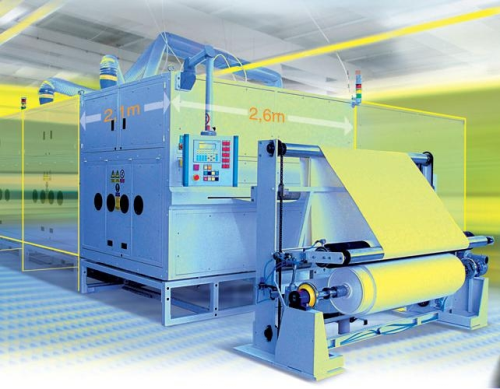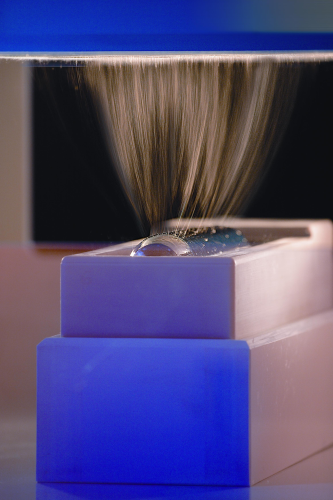

Over the past decade a number of methods have arisen to introduce nanofibres into filtration media. There have been numerous business models; toll converters applying a nanofibre layer to existing media, media manufacturers supplying a substrate with a nanofibre layer, and increasingly, capital equipment vendors providing either meltblown or electrospinning equipment capable of putting down a nanofibre coating at a filter fabricator or media producer’s plant.
While businesses focused on nanofibre applications have faced the same challenges as the rest of the filter media and nonwovens market over this time period, the number of nanofibre initiatives and products in the market has shown that it is no longer a question of when fine fibres will increase in adoption, but more a question of how they can be profitably introduced into products.
Nanofibres, while used in many markets, have the longest commercial product history in filtration. Many companies have worked with fine fibre methodologies, both as R&D efforts, production engineering challenges and increasingly as a method for improving profitability and performance in end filter products. In our work with customers pursuing nanofibre applications we see eight distinct phases in working with nanofibres;
1. Product selection2. Polymer selection3. Substrate4. Fiber formation method5. NF Layer6. Media design7. Post NF application operations8. Filter design9. Usage and supply chain
The importance of choosing the right project up front to bring in a nanofibre production process can’t be over-stated. The clearer the production problem or customer need, the more likely it is that the addition of nanofibres to a product will benefit the end customer. Many R&D driven projects are simple explorations of potential applications for nanofibres in end markets; while these are often successful they require some good fortune for products to make it to production. Nanofibre projects are most successful when there is a clear need and underlying support that nanofibres will improve product performance and solve the customers’ problems. When someone says, “We need to hit this efficiency, with this pressure drop in this kind of environment, and we suspect nanofibres will allow us to do so,” then they are beginning to head down a well defined product implementation path that can lead to successful nanofibre integration.
Clear objectives are important with nanofibre implementation, because there will be times when nanofibres aren’t the right tool. When the first iterations are done and the objective is still far afield, those early steps in defining what your goals are will allow you to walk away from projects that don’t appear as if they will be successful. The remaining steps of optimizing usage of nanofibres aren’t possible if you haven’t done the initial work to understand what your needs are; without initial parameters there are simply too many avenues to explore.
Polymer selection is crucial; what environment will the media be used in? Are there temperature constraints? Are there aggressive chemicals that will be filtered? Choosing the right polymer for the needed environment are crucial. Polyamides, Fluoropolymers and Polyolefin selection at the top level are crucial, specifying the specific part numbers are even more important.
Nanofibre layers can function as a thin coating layer on a substrate or at above 5 grams/square meter (GSM) as a membrane replacement layer. In both cases they will frequently be used in partnership with some kind of mechanical support, pre-filter or even a cover or drape for cosmetic purposes. Choosing the right substrate layers is important; if they are the deposition layer for the nanofibre deposition process it is important to understand the adhesion performance between layers. There are many ways to promote adhesion between the nanofibre layer and the substrate; finding the right method is a function of knowing the final operating environment of the final filter.
There are a number of ways to form a nanofibre layer; the primary dichotomy is between choosing a melt blown process or an electrospun process. Melt blown processes tend to have a wider distribution of fibre diameters and are not able to achieve consistently fine fibres below 500 nm. Within electrospinning, the two main process branches are needle-based or free-surface processes, represented by Elmarco’s Nanospider production equipment. Process evaluation for nanofibres is no different than it is for any other operation on a plant floor. This is a straight forward capital budgeting process; what kind of fibres do you need? What production metrics are driving your decision? How will I service the asset if it breaks down? Does the process match the training of my plant floor operators? At the end of this evaluation your process should give you a clear price per square meter of material.
When we evaluate the nanofibre layer, two key measures are evaluated, the nanofibre diameter and standard deviation as well as the basis weight. Like most nonwovens processes, reducing basis weight by half should double line speed. Fibre diameter is different; although bigger fibres can typically be put down more quickly, resulting in lower cost, and similarly, a wider distribution of fibre diameters can typically be put down more quickly, also resulting in lower cost.
One quick note on fibre distribution; fat fibres can have a huge impact on process productivity for a set level of filtration efficiency. A single 3 micron fibre in a 200 nm target out of 700 fibres can represent over 85% of the mass being put down in a process, whereas a well-controlled process could put over 99.9% of the mass to work improving filtration efficiency.
Media design is the intersection between substrate and the nanofibre coating. How will the different materials interact with each other in a flat sheet setting, prior to pleating and filter formation? While the software models around media design continue to improve, this is an area where empirical evidence still dominates. It remains more art than science. Solvent electrospinning is an area where the homogeneity of the fibre diameters allows the creation of a media layer that is tailored for a specific application. If this is a capability that isn’t present in house, there are a growing number of consultants with backgrounds in this field, particularly with experience around Elmarco’s equipment and its capabilities around solvent electrospinning.
Post nanofibre layer deposition, the media goes through many other manufacturing operations; the most challenging of which is usually the pleating step. There are a number of ways to ensure that the pleating step is not a point of failure; all of which are focused on understanding the adhesion characteristics of the nanofibre layer with the substrate on which it is originally deposited. As can be expected, blade pleaters are often easier to integrate than rotary pleaters. There are a number of nanofibre applications going through pleat processes on rotary pleaters at a rate greater than 800 pleats per minute. Throughout all of these operations there must be a focus on making sure that our polymer selection is not a constraint and that the entire media layer is functioning appropriately.
Many of these issues can be addressed by having the right person involved in your pre-site inspection prior to working with a nanofibre project. While ten years ago the number of people with such experience was limited, there are many teams that now have this knowledge such that these issues can be addressed earlier rather than later.
Filter design is another area where significant know-how and experience is required to create a product that is valuable to your end customers. The addition of a nanofibre layer can improve performance along several dimensions; most notable pressure drop, efficiency and dirt holding capacity, and if the media is crafted appropriately it presents a new set of tools for the filter designer.
The design of the nanofibre layer to optimize for the supply chain is important. As Von Hippel showed in his “Sources of Innovation” supply chain considerations are crucial in understanding when, where and how new processes are brought into an industry, and its why we’ve focused our business at Elmarco on providing simple to use, industrial-scale capital equipment for electrospinning. By making equipment that is usable by media manufacturers, filter makers or converters, our goal is to make it easy for the industry to work with nanofibres, regardless of where a company may be in the supply chain. By focusing on low cost, high productivity equipment, we believe that any player can move to a nanofibre enabled product when and where they choose.
In closing, the most crucial component in planning for the successful introduction is in the identification of a clear product and clear needs at the outset of the product design phase. With those criteria in place, understanding the requirements around polymer selection, substrates, fibre formation method, nanofibre layer, media design, post layer operations, and supply considerations can be answered by using the pre-identified criteria. The existing usage of nanofibres and potential applications for them in other areas of filtration is significant; executing a successful product introduction requires a clear understanding of knowing your customers needs.
A note on cost
The most important aspect of working with an application that may use nanofibres is having known costs. This may sound self-apparent; however many nanofibre projects have been just that, projects. Rather than customer-driven initiatives, they have been R&D focused fibre creation and feasibility plans with no clear path to implementation. This kind of R&D is no different than someone with a mining operation; the silver (or other precious metal) is always just around the corner and you’re always halfway there. If you are working with a nanofibre group that cannot provide you with a known estimate of the cost of the nanofibre layer or of the capital equipment you would purchase, then you are not working on product design; you are working on R&D. R&D has its place, but know that is the activity you are involved with.





